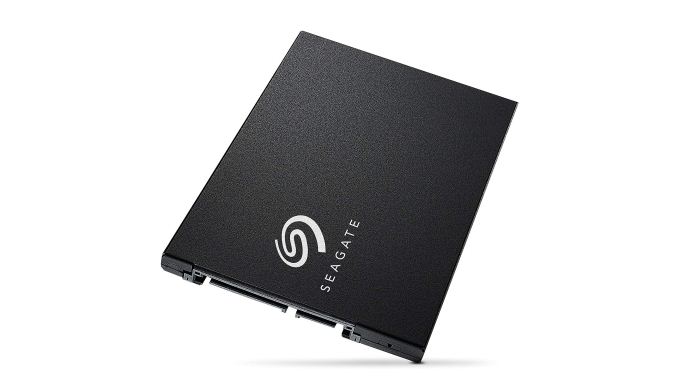Seagate Announces BarraCuda Consumer SATA SSD
by Billy Tallis on July 3, 2018 5:15 PM EST
Seagate has pretty much always been a major player in the storage market, where they're known primarily for their hard drives. They haven't been completely absent from the SSD market, but they have focused almost exclusively on the enterprise SSD market. It has been quite a while since we've seen a consumer-oriented SSD from Seagate, but the new BarraCuda SATA SSD brings them back into play.
The BarraCuda SSD comes with minimal technical specs, but what we have so far points to a mainstream SATA drive that probably uses current-generation 64L 3D TLC NAND flash memory and a controller with the usual DRAM cache. The internals may offer a hint as to Seagate's plans for the consumer SSD market: if the BarraCuda is just a Silicon Motion reference design, then Seagate may not be very serious about competing in this market segment. If they've written their own firmware for a Silicon Motion or Marvell controller, then the BarraCuda is more likely to be an interesting competitor and less likely to be another one-off product.
| Seagate BarraCuda SSD Specifications | ||||
| Capacity | 250 GB | 500 GB | 1 TB | 2 TB |
| Model Number | STGS250401 | STGS500401 | STGS1000401 | STGS2000401 |
| Controller | unspecified | |||
| NAND Flash | Toshiba 64-layer 3D TLC NAND | |||
| Form-Factor, Interface | 6 Gbps SATA, 2.5" | |||
| Sequential Read | up to 540 MB/s | |||
| Sequential Write | up to 520 MB/s | |||
| Random Read IOPS | up to 90k IOPS | |||
| Random Write IOPS | unspecified | |||
| DRAM Buffer | unspecified | |||
| Warranty | 5 years | |||
| MTBF | 1.8M hours | |||
| Write Endurance | unspecified | 1092 TB 0.3 DWPD |
||
| Price | $74.99 (30¢/GB) | $119.99 (24¢/GB) | $229.99 (23¢/GB) | TBA |
Pricing appears to be only slightly higher than competitors like the Crucial MX500 or WD Blue, which is to be expected since Seagate doesn't have the benefit of manufacturing their own flash memory (though they are now a minority shareholder of Toshiba Memory). The five year warranty and 0.3 DWPD endurance rating are standard for mainstream consumer SATA SSDs.
Seagate is planning a limited release through Amazon Prime this month, followed by broad availability in September.
Source: Seagate










21 Comments
View All Comments
Holliday75 - Tuesday, July 3, 2018 - link
Interesting, but the pricing puts it in the middle of the pack so to speak. Hard to justify buying one without reviews.Who here wants to spin the wheel and see what happens?
rnalsation - Tuesday, July 3, 2018 - link
Why would they use an off the shelf controller when the bought the ssd controler portion of LSI?rnalsation - Tuesday, July 3, 2018 - link
Anand even published the release https://www.anandtech.com/show/8073/seagate-acquir...Billy Tallis - Tuesday, July 3, 2018 - link
If they were going to actually produce a new competitive or even usable controller from the remnants of SandForce, they would have done so by now and used it in the enterprise space where they could have a chance of recouping development costs. Instead, they've been shipping tons of Marvell controllers. SandForce is dead.gfkBill - Tuesday, July 3, 2018 - link
As dead as the pile Intel 535's on my desk...Samus - Thursday, July 5, 2018 - link
hahaha ditto, I feel bad for people who buys those 535's dirt cheap on eBay thinking they are getting a quality Intel drive when they are probably the most failure prone SSD's in recent memory...mostly down to just poor firmware thrashing the NAND.milkod2001 - Wednesday, July 4, 2018 - link
They are clearly rebrands with Seagate stickers on them. Not sure what to be excited here about. Maybe if they were super cheap? Otherwise why to bother?Gothmoth - Wednesday, July 4, 2018 - link
no reason to choose this over a samsung SSD.Samus - Thursday, July 5, 2018 - link
well, it will be substantially cheaper. but I agree there will likely be better options.yeeeeman - Wednesday, July 4, 2018 - link
The logic is simple today. Every single manufacturer or OEM wants to be in the SSD business because they sell. People don't buy HDDs anymore and probably SSDs are dirt cheap to make. I doubt that the 2TB SSD is more than 50$ in actual value, so the difference is profit for seller. Which is quite a big profit tbh.